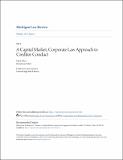| dc.contributor.author | Roe, Mark J. | |
| dc.contributor.author | Venezze, Federico Cenzi | |
| dc.date.accessioned | 2017-01-19T21:33:39Z | |
| dc.date.issued | 2013 | |
| dc.identifier.citation | Mark J. Roe & Federico Cenzi Venezze, A Capital Market, Corporate Law Approach to Creditor Conduct, 112 Mich. L. Rev. 59 (2013). | en_US |
| dc.identifier.issn | 0026-2234 | en_US |
| dc.identifier.uri | http://nrs.harvard.edu/urn-3:HUL.InstRepos:30011107 | |
| dc.description.abstract | The problem of creditor conduct in distressed firms — for which policymakers ought to have the economically-sensible repositioning of the distressed firm as a central goal — has vexed courts for decades. Because courts have not come to coherent, stable doctrine to regulate creditor behavior and because they do not focus on using doctrine to facilitate the sensible repositioning of the distressed firm, social costs arise and those costs may be substantial. It’s easy to see why developing a good rule here has been hard to achieve: A rule that facilitates creditor operational intervention going beyond ordinary collection on a defaulted loan can induce creditors to intervene perniciously, to shift value to themselves even at the price of mismanaging the debtor. But a rule that confines creditors to no more than collecting their debt can allow failed managers to continue mismanaging the distressed firm, with the only real managerial alternative — the creditor — paralyzed by judicial doctrine.
The doctrinal difficulty and the potential for creditor paralysis arise from unclear and inconsistent judicial doctrine. Some courts hold that it’s the creditor’s inequitable control of the debtor that is the characteristic that leads to creditor liability. Others rule that the creditor contract rights go beyond simply suing and collecting, fully allowing the creditor to condition its own forbearance from suing on the debtor complying with the creditor’s wishes, even if the conditions are costly to the firm’s other creditors. Worse for encouraging positive creditor engagement, the doctrinal standard via which courts shift from protected contract rights to perniciously-exercised control is obscure. Leading cases have the same basic facts, sometimes even the same court, but sharply differing results. Creditor control is the key doctrinal metric; but the creditor’s goal is the better metric for judicial focus.
Here we show, first, that there is often no on-the-ground, operational difference between these two standards — pernicious control and free-wheeling contract enforcement — and that this lack of sharp difference helps to explain why the judicial results are vexing, contradictory, and costly. We next show how similar problems are dealt with differently in corporate law settings — by courts evaluating the questioned transaction for business judgment deference to boards of directors . Then we show how putting a layer of basic corporate duties — entire fairness for conflicted transactions and business judgment rule deferential review for non-conflicted transactions — atop the creditor intervention doctrines clarifies the creditor in control problem and lights up a conceptual way out from the problem. A safe harbor for creditors is plausible — if courts could reduce the extent of creditor conflict for critical decisions — and would both encourage constructive creditor intervention and discourage detrimental value-shifting creditor intervention. And then we show that modern financial markets yield a practical way out, using this corporate doctrine as the map: Modern capital markets’ capacity to build options, credit default swaps, and contracts for equity calls provides new mechanisms that, when combined with the classic corporate doctrinal overlay, can better inform courts and parties on how to evaluate and structure creditor entry into managerial decisionmaking. The capital markets and corporate doctrine combination can create a doctrinal conduit to better incentivize capital market players to improve distressed firms than the current doctrines regulating creditor conduct. | en_US |
| dc.language.iso | en_US | en_US |
| dc.publisher | University of Michigan, Dept. of Law | en_US |
| dc.relation.isversionof | http://repository.law.umich.edu/cgi/viewcontent.cgi?article=1041&context=mlr | en_US |
| dc.relation.hasversion | http://ssrn.com/abstract=2103217 | en_US |
| dc.relation.hasversion | http://www.law.harvard.edu/programs/olin_center/papers/pdf/Roe_735.pdf | en_US |
| dash.license | LAA | |
| dc.title | A Capital Market, Corporate Law Approach to Creditor Conduct | en_US |
| dc.type | Journal Article | en_US |
| dc.description.version | Version of Record | en_US |
| dc.relation.journal | Michigan Law Review | en_US |
| dash.depositing.author | Roe, Mark J. | |
| dc.date.available | 2017-01-19T21:33:39Z | |
| dash.contributor.affiliated | Roe, Mark | |


